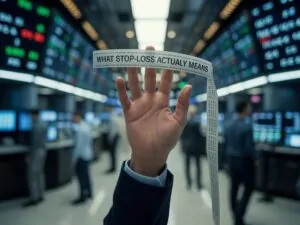How stop-loss works and why you need it in trading
In the world of trading, success isn’t только about spotting the next big opportunity — it’s just as much about knowing how to protect your capital when things don’t go your way. This is where a stop-loss order becomes an essential tool. Designed to limit losses by closing your position automatically once a certain price level is reached, the stop-loss is less about predicting the market and more about managing risk. For traders of all levels, understanding how and when to use stop-losses is a foundation for staying in the game.
What stop-loss actually means

A stop-loss order is a predefined instruction to your broker to sell (or buy, in the case of short positions) an asset once it reaches a certain price — one that typically reflects the maximum loss you’re willing to tolerate on a given trade. It’s like setting a personal line in the sand: if the market moves against you beyond that line, you’re out. For example, imagine you’ve bought a stock at $150 and set a stop-loss at $140. If the price falls to that level, the system will automatically sell your position, limiting your loss to $10 per share.
This automation removes the need to monitor the market every second and prevents emotions from taking over during volatile moments. It won’t guarantee the exact price — especially in fast-moving markets where slippage can occur — but it’s a far better alternative than holding a losing position out of hope or fear.
Why stop-loss is essential for traders
Using a stop-loss is not just about limiting downside; it’s about trading with a plan. It forces you to define your risk before you enter a position, rather than deciding on the fly when losses start to pile up. Many traders, especially новичков, avoid setting stop-losses because they see them as a sign of weakness or lack of confidence. In reality, it’s the opposite — it’s a sign of discipline.
There are several reasons experienced traders use stop-losses consistently:
- Protecting capital — Helps avoid large drawdowns and preserve funds for future trades.
- Maintaining emotional control — Removes the need for impulsive decisions in stressful situations.
- Improving risk/reward planning — Makes it easier to calculate position size and target profit.
- Sticking to a strategy — Encourages consistency rather than reaction-based trading.
Without a stop-loss, every trade becomes a gamble. With it, you’re trading based on rules — not reactions.
Common types of stop-loss orders
Not all stop-losses are created equal. Depending on your trading style, risk appetite, and the instrument you’re trading, you might choose a different type of stop-loss. Some traders prefer tight, aggressive stops, while others opt for wider buffers to allow for market noise. The key is to understand the method that suits your strategy.
Here are the most widely used stop-loss types:
- Fixed stop-loss. A specific price point below or above your entry, often used in simple setups.
- Trailing stop-loss. Moves with the price when the trade goes in your favor, locking in profits automatically.
- Percentage-based stop-loss. Set according to a fixed percent of the entry price, often 1–2%.
- Volatility-based stop-loss. Uses indicators like ATR to adjust stop distance based on current market conditions.
Before choosing, consider how volatile the asset is and how often you’re willing to be stopped out prematurely. There’s no universal answer — only what aligns with your overall strategy.
A real-life scenario: risk managed, losses minimized
Let’s take a scenario that many traders will recognize. Suppose you open a long position on an index at 3200 points, expecting a breakout toward 3300. To manage your risk, you place a stop-loss at 3175 — just below recent support. The market dips slightly and hits your stop. You’re out with a small, controlled loss. A few hours later, the index plunges to 3130 due to unexpected news.
This simple stop-loss prevented a deeper loss that could have impacted your trading capital — and confidence. That’s the power of planning ahead.
The takeaway
Some traders convince themselves they’ll “watch the trade” and close it manually if things go wrong. That sounds reasonable in theory, but markets can move faster than your fingers — and certainly faster than your emotions. A stop-loss doesn’t just protect your money; it protects your mindset. It gives you room to recover, reflect, and move on without fear or revenge-trading.
Using stop-losses consistently won’t eliminate all risks, but it will put you in control. Instead of hoping for the best, you’ll be trading with a clear framework. So, next time you open a trade, ask yourself: have I set my exit just as clearly as my entry?